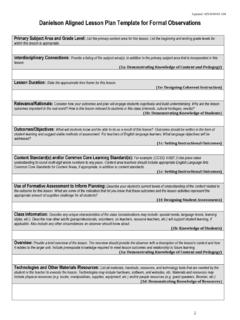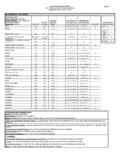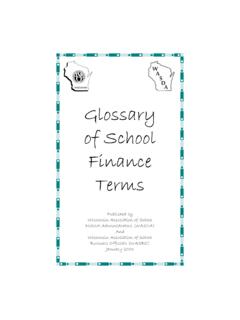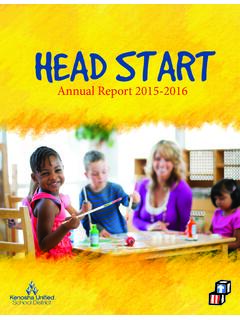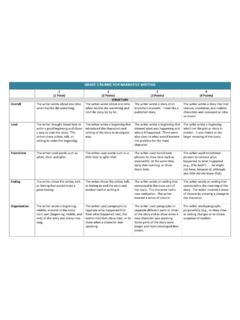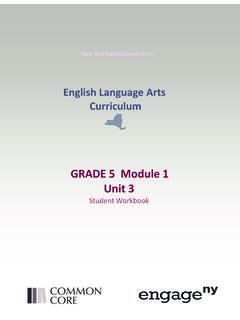Transcription of UNIT OF STUDY 3 GRADE 3 Reading/Language Arts Grade
1 1 ELA Curriculum Alignment Documents for Quarter 2, 2013 unit OF STUDY 3 GRADE 3 Reading/Language Arts GRADE 3 unit of STUDY Understanding Structure unit Number unit of STUDY 3; Correlates with Journeys unit 3 Reading Level Expected Beginning of unit Level: Expected End of unit Level: Description of the unit This unit focuses on asking questions to build understanding. Readers ask questions to understand characters, think about story structure and use text features. Questions help readers know what they understand and know where they have confusions. Understanding Characters A character is anyone in a story, and the main character is the most important character.
2 You can explore different characters and their traits, which describe what someone or something is like and how they look or act. You'll learn how a character might grow and change in a story. You can use a chart or other graphic organizer to help you gather and organize ideas to help you understand characters. Writers attempt to make their characters seem real through the characters appearance, action, speech, and thoughts, as well as the thoughts and comments of other characters. As an author reveals characters, the reader becomes familiar with them. When we get to know characters, we get more enjoyment from the story as well as have a better understanding of it.
3 Text Features Text features include: guide words, title page, table of contents, index, glossary, heading, subheading, keywords, illustrations, photographs, captions, diagrams, labels, text box, maps, charts: schedules, tables, etc., bold text. These features and others guide readers to notice important information. Sequence of Events & Story Structure At this stage, students will use story structure and sequence of events to summarize. Story structure includes setting, plot, problem, and resolution. Suggested unit Launch Tell students that active readers ask questions before, during, and after reading. Explain that readers ask and answer questions to help them understand what they are reading.
4 When we ask questions we are actively involved in the text. Readers ask questions about what they think will happen next or what words means. They ask questions when they are confused or when they are wondering why something happened. Select a story in which a character learns a lesson , such as Lily s Purple Plastic Purse by Kevin Henkes. Brainstorm and record questions before, during and after reading about Lily s feelings throughout the story. Be sure to cite text evidence to support thoughts. Question frames may include, What caused the main character , Why did the main character , What could the main character have done instead Wrap up with a discussion about how asking questions helps keep track of the story sequence and helps readers understand characters more deeply.
5 Selecting Texts for this unit of STUDY When choosing texts, find main characters that will be of high interest to your readers. You will want to find characters that your students will want to understand deeply. Characters do not need to be fictional, so it is important to balance fiction and informational text. Also, look for texts with interesting charts, tables and graphics to provide opportunities to draw meaning in new ways. Pacing 25 Days; End of Quarter 2 & Beginning of Quarter 3 2 ELA Curriculum Alignment Documents for Quarter 2, 2013 unit OF STUDY 3 GRADE 3 Desired Results Essential Questions Corresponding Big Ideas 1.
6 What makes a character interesting? 2. What clues in a story help you understand its characters? 3. What text and graphic features support your ability to get the meaning of the text. 4. What words show the order of events in a story? How do characters affect the plot of a story? 1. Readers use clues to understand characters. 2. Readers use text features to know where to focus attention. 3. Readers keep track of the sequence of events to help them understand what they read. Assessment Evidence Evidence of Proficiency Questions for Teacher Team to Ask Prior to the Launch of the unit What rubrics will need to be created to show proficiency?
7 What output will show an understanding of character? How can reading and writing work together to build on the ability to understand story sequence and structure? What text and graphic features should a 3rd Grader be able to interpret? Formative Observation Conferring with Students Running Records Writing Samples and Journal Entries Constructed Response with cited text evidence Student character notes in Response Journals Story Outlines Summative Fountas and Pinnell Benchmark Assessment System with focus on comprehension questions Writing Sample with teacher-team developed rubric Academic Vocabulary character conclusion motive alike story structure predict summarize relationship similar opinion plot solution traits different fact 3 ELA Curriculum Alignment Documents for Quarter 2.
8 2013 unit OF STUDY 3 GRADE 3 Common Core Standards and Learning Targets Priority Standards Learning Targets Ask and answer questions to demonstrate understanding of a text, referring explicitly to the text for the basis for the answers. I can ask and answer questions, using the text for support, to show my understanding. Recount stories, including fables, folk tales, and myths from diverse cultures; determine the central message, lesson , or moral and explain how it is conveyed through key details in the text. I can retell a story. I can tell the central message of a story, and identify how the message is conveyed.
9 Describe characters in a story ( , their traits, motivations, or feelings) and explain how their actions contribute to the sequence of events. I can describe the characters in a story and explain how their actions contribute to the story s events. Determine the meaning of words and phrases as they are used in the text, distinguishing literal from nonliteral language. I can determine the literal and figurative meaning of words an author uses. Refer to parts of stories, dramas, and poems when writing or speaking about a text, using terms such as chapter, scene, and stanza; describe how each successive part builds on earlier sections.
10 I can describe when there are different characters telling a story. I can explain how parts of text (chapters, stanza, etc.) are connected. I can use specific terms (chapter, stanza, etc.) when discussing a story or text. Distinguish their own point of view from that of the narrator or those of the characters. I know the point of view is the perspective from which a story is being told. I know stories may be told from the narrator's point of view or from a character's point of view. I know readers can formulate their own personal point of view or opinion about events in the text based on their background knowledge and what the author allows the reader to see and hear in the story.
